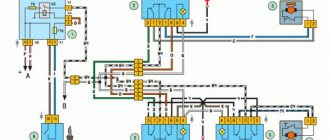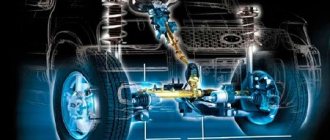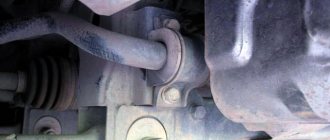Why do we need Hydronic?
This additional module, installed on a car, can warm up the coolant to operating temperature when the engine is not running. From the heated antifreeze, the engine reaches operating temperature, which allows you to immediately begin driving after starting, without wasting additional time. In addition, fuel is saved, the load on batteries (battery) and the overall wear of engine parts are reduced. Additional advantages of using Hydronic are a warmed-up interior and defrosted windows before the start of the trip. This is an important advantage from using the device, since an acceptable interior temperature directly affects driving safety - it allows the driver to pay full attention to the road without being distracted by the cold. In addition to the function of warming up the cooling fluid, regardless of starting the engine, the hydronic heater also supports the ability to “reheat” it.
Autostart or Webasto?
In addition to the market today, there are devices that are also designed to warm up the engine in winter, but have a different principle of operation. They are called autostart and allow you to start the engine remotely. In fact, we can consider that this is a fairly good analogue for Webasto. Such equipment has become quite widespread. However, in comparison with Webasto, it, unfortunately, has a number of certain disadvantages. The most important of them is that the use of autostart significantly reduces the efficiency of the machine’s anti-theft equipment. The fact is that such devices are usually included in the same circuit with the alarm system (to prevent it from being triggered upon startup).
Also, the disadvantages of such equipment, in comparison with Webasto, are:
- When using autostart, the car engine wears out much faster.
- High fuel consumption
. Programmable autostart systems have this disadvantage. When using such equipment, for example, in an unheated parking lot, it can start several times (when the temperature drops to certain values). - Unlike Webasto, its analogue - autostart - does not guarantee a perfect start in severe frost.
Compared to autostart systems, Webasto has another undoubted advantage. Thanks to a device of this brand, connected to the standard heating system of the car, you will be able to wait for help, for example, if your car breaks down on a winter highway, in a warm, rather than frozen, interior.
Operating principle and technical characteristics
Connection diagram for Hydronic to the cooling system
The heater is installed in the vehicle system and for its operation consumes fuel (from 400 to 700 ml per hour of operation) and electricity (from the battery). Therefore, for its operation it is also necessary to calculate the fuel reserves and monitor the battery charge. Gidronik's operating instructions describe the following operating principle of the device: after starting the heater, fuel and air enter the combustion chamber installed in the device, where they burn and heat the coolant. Hot antifreeze is directed through a pump into the car's cooling system, where it transfers heat to the engine, as well as to the radiator of the interior heater. The system sets temperature thresholds, upon reaching which Hydronic works partially, maintaining the temperature, turns off (if the upper limit is exceeded) or turns on automatically if the liquid begins to cool. The time for a full heating cycle is approximately 40 minutes. Its performance is comparable to several boilers, but the power consumption is significantly lower, which significantly saves battery power. During startup, Hydronic uses less charge than one low beam lamp. In addition, if the battery charge is insufficient, the heater will not start working. Having examined Hydronic and the principle of operation of the device, let’s move on to studying its technical characteristics (for a passenger car model):
- The voltage used is 12 V;
- Output power when heating from 2400 to 5000 W;
- Electrical power consumption: from 23 to 50 W;
- Overall dimensions of the device – 220 x 86 x 160 mm
- Fuel consumption during operation – 0.27 – 0.62 l/hour
- Hydronic weight from 2.9 kg.
Article on the topic: A car for a woman with an automatic transmission: features of choice
HYDRONIC error codes
Checking the battery charge
If the preheater does not start, and “Error” appears on the display of its modular timer, then by independently identifying the malfunction and eliminating it, you can diagnose the device. It is better to check the heater and remove errors and the malfunctions that caused them as a preventive measure. Heater error codes and brief description of the malfunction:
- 011, 012—voltage thresholds exceeded. Most often caused by battery discharge, generator breakdown, broken wiring, oxidation of contacts;
- 012, 014 - overheating or possibility of overheating. Impaired coolant circulation, leakage, air pockets. Failure of the circulation pump, temperature sensors;
- 015 - controller blocked due to overheating. The reasons are the same as for errors 012 and 014. The error must be removed;
- 017 - emergency shutdown caused by overheating. The reasons are stated above;
- 020, 021 - spark plug malfunction;
- 030, 031, 032, 038, 039 — the air intake fan speed has changed. The main reasons are increased resistance to rotation due to contamination, open circuit of the fan power supply, shorted wiring, oxidation of contacts;
- 041, 042 – malfunctions related to the circulation pump and its power supply;
- 047, 048 – breakdowns in the fuel supply system associated with the metering pump;
- 050 – blocking of the control unit due to unsuccessful starts. It is necessary to delete the error after troubleshooting;
- 051, 052 - exceeding the permissible time. Failures related to the flame sensor, operation of the metering pump, air supply to the combustion chamber;
If other error codes are displayed, it is best to contact a specialist, as special tests will be required on professional diagnostic equipment. Repairing the Hydronic “brains” is an activity for electronics professionals; semiconductors can fail even from the slightest discharge of static electricity caused by touch.
Turning on the heating
Hydronic heater control panels
There are several ways to get Hydronic, the preheater, to work. The standard option is to display a button or screen with additional settings in the car interior. This is not entirely convenient, as it requires going to the car to start heating.
You can set the start by timer and the heater will heat the coolant at the specified time. This option is of course more convenient, but it may not be suitable for everyone, since you don’t always know when you need to go. An excellent solution is to install an additional Hydronic gsm module, and the heater can be controlled from the alarm key fob. If the signaling is simple, without gsm, then, for example, a system for pre-heaters is suitable, which is installed in the interior under the panel and involves the use of any convenient SIM card. Control is done by dialing a specific number on the phone, and in response you receive a complete description of the system state - from engine temperature to battery voltage. Also, all of these system startup options allow for various combinations with each other. The operating time of the Hydronic preheater is set based on the air temperature. When the thermometer readings are up to -10, the suitable operating time is from 20 to 40 minutes. If the temperature is lower, the operating time is extended to two hours. There are models of timers for Hydronic that automatically calculate the operating time of the heater - the car owner only sets the time of the intended trip.
Which preheaters are better - Webasto or Binar?
In October 2020, on PartReview, Webasto preheaters were generally better than Binar.
- Binar took 1st place in the ranking with a PR score of 99, and Webasto took 2nd place in the ranking with a PR score of 98.
- Webasto's average review score (4.4) is higher than Binar's (4.3).
- Webasto preheaters have better property ratings than Binar:
- Warm-up speed - owners believe that Webasto has this property better than Binar.
- Installation - car enthusiasts claim that this property of Binar is superior to Webasto.
- Durability - according to reviews it is clear that this property is preferable for Binar than for Webasto.
Device cost
A separate issue is the price of Hydronic, which depends on the model and power of the device. You can find this heater for 28 -29 thousand rubles, and some models cost up to 70 thousand rubles. Its installation in a professional center will cost 8-15 thousand. Additionally, you can purchase a control panel that operates remotely, but this will also require investment. For this useful application you will have to pay from 13 to 18 thousand. At the same time, it supports the ability to program the heater for 24 hours, and up to three start time options are installed. The range is up to 1 km, in the absence of signal interference. So, how much does Hydronic cost? Its total cost - purchase, installation, additional devices - will cost an average of 60-100 thousand rubles, and if this is your option, we will consider its scope and installation.
Article on the topic: What does a driver do when stuck in traffic jams?
Mitsubishi Pajero Sport › Logbook › Installing hydronics
There is an incomplete Hydronic B5WSC kit consisting of the boiler itself, wiring, suction, exhaust pipe and dosing pump. I’ll say right away that I’m a mess in this matter, but I’ve dug through a lot of information.
1. We are looking for the missing components in the Exist: - a Gates rubber fuel hose (3.5 mm in diameter) (code 3225-00050) for connecting the main fuel line. - half a meter at a glance, but they sell by the meter for about 100 rubles - a 5 meter fuel line hose (Webasto heater, why do that, even though it’s Hydronic?) (code 20688A) - 335 rubles - later it was replaced with the original Hydronikov one - along the internal section there are differences. - Connecting fittings are also Gates (code 7315-00912) - 90 degree angled 19*19 mm (well, there are no such 19*15!) - 1 piece - 90 rubles (code 7315-00923) - straight 19*15 mm - 1 pcs - 90 rubles Let me explain, the original hoses for the stove are 15 mm, for the Hydronic - 18 mm, respectively, we make the connection through these fittings. — The cooling system pipe, I would also like Gates, but the order was constantly cancelled, either it was out of stock, or the price changed (5 times!), I had to supply antifreeze from the store for now... by the way, I need a little, 70 centimeters in total. — as practice has shown (after 5 years), they live normally. — Clamps Norma 16-22 – 6 pcs and small clamps – 4 pcs — Plastic ties 30 pcs.
2. Day one The first problem I encountered was where to get the gasoline from? You can’t cut into the direct feed through the tee due to the pressure; you could think about the return. True, I didn’t see with my own eyes the return pipe, how long it is. New Hydronics are equipped with a fuel intake, a sort of thin tube 40 centimeters long... in reality this thing costs 2.5 thousand rubles, isn’t it a lot? I decided to make it myself: I buy a brake pipe from a classic Lada for 45 rubles, straighten it, bend the fitting at an angle of 90 degrees, saw off the excess, drill out the fitting nut, pour cold welding into the resulting space, select the nut accordingly, and that’s all - the needle is ready. If necessary, I can tell you in more detail later. Further more - our Sports DO NOT have a technological hatch under the rear seat for access to the fuel module. Fuck! What remains? That’s right, remove the entire tank, which is why you need a hole: - roll out the gasoline until it’s thawed (I don’t know about you, but I don’t have a fuel drain plug either) - fill the tank bolts under the bottom with VD so that they become acidic - release the pressure in the fuel line - well, that’s it Murzilka so, who knows where the fuel relay is located - tell me. I simply removed the latch and pulled off the fuel line from the filter - 100 grams of gasoline poured out. - remove the protection from below - remove the casing in the rear left wheel arch - here it’s interesting, they didn’t want to remove the hoses at all, even though the HP was splashing, we had to completely remove the filler pipe - remove the clamps, 3 bolts under the gas tank cap and 1 bolt of the pipe holder, after that everything was fine. — unscrew the 4 bolts securing the tank and carefully lower the tank by 10-15 centimes so that you can reach the electrical connectors while swearing. This helped me with one device in a friend’s garage - a rolling board on rollers with a jack attached to it and another board. If this were not the case, I think it would be difficult without an assistant. — If I haven’t forgotten anything, then that’s it. We take out the tank, remove the fuel module (8 nuts), drill a 9 mm hole in it, install the needle, and put it back together. Before installing the tank, we must put 1-1.2 m of Hydronikov hose on this same needle! Then you can't get there. “We’re putting everything back together, swearing.” — On the left side of the frame, a fuel metering pump is installed, to which the second end of a 1-1.2 m Hydronikov hose is attached. Yes, the pump is placed at an angle of 15 degrees.
Features and differences of Hydronic and Webasto heaters
So, let's start with general information and the complexity of selection, and also touch on the thermal power in different operating modes of the heaters. At the same time, we will touch upon the issue of fuel consumption and loads on the on-board network, the intensity of battery discharge, overall dimensions and a number of other important parameters.
- Webasto preheaters are offered for both gasoline and diesel engines. For passenger cars, the company offers different models that differ in power.
As an example:
- Webasto preheater for passenger vehicles whose engine capacity does not exceed 2.0 liters;
- heater for cars with an engine from 2.2 liters;
- autonomous heating boilers for commercial vehicles and SUVs with an engine capacity of 4.0 liters or more, etc.
Webasto heaters can additionally be equipped with a programmable timer, remote control, and GSM module. Among the main disadvantages, consumers note the high initial cost of installation kits, spare parts and additional equipment, and the freezing of liquid crystal screens on standard controls in severe frosts.
- As for Eberspächer and Hydronic, in the manufacturer’s catalog you can also find various models for various types of vehicles and power units installed on vehicles. Retrofitting options also include different heater controls.
- Hydronic 4 heater for cars with a volume of up to 2.0 liters;
- Heater Hydronic 5 for vehicles with engines over 2.0 liters;
- Hydronic MII model for trucks, commercial vehicles and special equipment with engines of 5.5 liters or more, etc.;
Let's move on. As mentioned above, today the main differences between Webasto and Hydronic for the average buyer come down to ease of selection, affordability, features and ease of installation. Also, special attention is paid to the warranty policy, the number of service centers, the general maintainability of heaters, the simplicity and cost of post-warranty repairs and maintenance.
As for selection, it is much easier to decide on the required model in each specific case when choosing from Webasto catalogs. In this case, you need to take into account the main differences in power (4-5 kW) and type of internal combustion engine.
Please note that when selecting from Eberspächer products, additional difficulties may arise, since there are more types of boilers (spaced and non-spaced), standard, Compact/Comfort series, etc. Then from each series you need to select a suitable 4 or 5 kW heater.
Such features indicate that in the case of Hydronic, as a rule, additional professional advice is required. You should also understand in more detail the intricacies of installation and other nuances of installing this or that type of heater from this company.
Heater installation
Note that the basic installation of Webasto and Hydronic does not imply any significant differences, since these devices operate on the same principle. At the same time, the Eberspächer installation kit can be considered more complete, which somewhat simplifies installation in some cases. We also add that the Webasto heater is packaged much better.
As for the individual installation features, I would like to separately mention some points. Taking into account the fact that each manufacturer offers several options for heaters for gasoline and diesel internal combustion engines, for objectivity it is necessary to compare two devices with similar characteristics (for example, Hydronic 2 Economy and Webasto ThermoTop).
In turn, the design of the Hydronic model compared with its competitor has three nozzles, not two. There is one input nozzle, but two output nozzles. This feature allows you to install this heater in different ways.
- The first method is similar to installing Webasto, that is, one of the outputs is silenced, and the heater itself warms up the engine circuit and the heater radiator.
- The second solution allows you to connect the heater so that the main emphasis will be on driver comfort and warming up the interior space, rather than the internal combustion engine. First of all, the heater radiator circuit warms up, while the power unit circuit is turned off.
When the interior heating circuit is heated to a temperature of about 65 degrees, and this happens quite quickly, the circuit is then opened to the engine, without significant heat losses. According to this scheme, two circuits are heated with priority for heating the interior.
- Another connection option allows you to prioritize warming up the engine, and only then the interior. The scheme resembles the second method, but the internal combustion engine circuit warms up first, while the interior heating is turned off.
After the coolant in the engine circuit has warmed up to the required temperature, parallel heating of the cabin circuit begins, that is, two circuits are activated. This connection method allows you to warm up the internal combustion engine as quickly as possible and facilitate cold starts.
We also add that many installers note the lower performance of the Hydronic metering fuel pump compared to Webasto. Based on this, during installation it is necessary to take fuel from the fuel tank only through a special fuel intake.
Heaters for VAZ “Start M-1”
This low-kilowatt device is intended for heating the internal combustion engines of passenger cars, mainly VAZ brand. “Start M-1” devices belong to the network class and operate at a voltage of 220 V. These devices have received relatively good reviews from consumers. They warm up engines in winter quickly, without problems and guaranteed. Start M-1 heaters are supplied to the market in a molded casing, and the dimensions are not too large. All this, of course, increases their service life and makes them as convenient to use as possible.
Most consumers consider Start M-1 heaters to be practical and high-quality equipment. A car engine using them at an ambient temperature of -25 C can warm up in literally an hour. Such heaters cost only about 3-5 thousand rubles.
Webasto engine preheaters are widely known throughout the world and have become widespread on different models and types of vehicles. The name Webasto in everyday life is often used today to refer to the very fact that the power unit is additionally equipped with an autonomous engine heater.
Prices, warranty, repairs and maintenance
The current pricing policy of both competing brands is such that today you can buy Webasto or Hydronic for almost the same price. It should be taken into account that the price for Webasto is usually fixed at various dealerships.
In the case of Hydronic, this practice is less common, so prices for heaters from this company may differ from different sellers. This allows for a wider choice, as there is a chance to purchase a product at a lower price than the average price.
Taking into account this fact, Webasto products in practice may turn out to be 3-5% more expensive, but such a difference does not particularly affect the choice. As for the cost of installing pre-heaters, the price will be the same (from 6 thousand rubles or more, which depends on the complexity of installation on a particular vehicle).
We also note that additional controls and controls for the Eberspacher heater are cheaper than similar analogues from Webasto. It is also possible to connect the Hydronic control via an additional alarm channel.
However, such a connection does not lead to loss of the factory warranty for the heater. If it is necessary to implement additional control of the heater from a smartphone, this feature allows you to save about 10 thousand rubles.
If we touch on the issue of warranty, repair and maintenance of heaters, then it will be cheaper to repair Hydronic than Webasto. The fact is that Eberspächer provides for separate replacement of various elements, while Webasto has developed the practice of replacing entire modules.
This means that if any individual part in a module fails, then the entire module assembly must be replaced. As a result, the cost of Webasto spare parts is higher. Compared to Webasto repairs, minor Hydronic repairs will be less expensive.
The general warranty for both types of heaters is the same and is 24 full months from the date of installation on the vehicle. However, the terms of the warranty are slightly different. Webasto has a full guarantee, but Hydronic does not provide a guarantee for all elements and types of kits.
As an example, it is worth mentioning the glow pin, which Webasto can easily change under warranty, which cannot be said about Hydronic. Also, the warranty for installation kits for trucks from Hydronic is 1 year (12 months), and Webasto gives a 2 year warranty (24 months).
Eberspächer score compared to Webasto
Installation of the Binar heater under the right wheel bumper.
Russian developers of heaters are undoubtedly making progress, creating equipment that better meets the requirements of car owners than the first samples - the range of settings for heating systems is expanding; heaters already have a modular structure that allows you to expand the capabilities of controlling the device at a distance by purchasing and installing additional equipment. But so far, at least according to reviews from companies that install heaters, requests for warranty issues are more often associated with Binar installations.
The biggest disadvantage of the Binar heater at the moment is the larger size and weight of the boiler itself than its “big brothers”. Another disadvantage noted by the owners is the faster discharge of the battery than when warming up with Webastoy. But Binar also has undoubted advantages:
- possibility of installing the boiler in different positions;
- ease of rebooting the controller when it is blocked as a result of failed launches;
- the control panel display does not freeze, like on Webasto;
- the remote control display shows the coolant temperature value, which makes it possible to control the heating - this is not available on imported analogues;
- significantly lower cost of the device and spare parts;
- the possibility of installing another coolant pump and “registering” its data in the memory of the control unit.
https://www.youtube.com/watch?v=https:tv.youtube.com
In conclusion, we can only advise you to study the reviews of the owners of a specific heater model, preferably those you know personally. Studying the characteristics of devices from documents will not give such a comprehensive answer as checking them in practice.
Fast start and high efficiency. The heating rate of the entire circuit and the temperature threshold for the transition to purging are, subjectively, higher than that of Webasto. The circuit heats up faster, and this is not so pronounced on my Comfort version, but very noticeable on the Hydronic 2 Economy version - an analogue of ThermoTop with two nozzles.
Energy consumption - 40W. Webasto is higher.
Interior and engine heater in one. Of course, it’s not a panacea for severe frosts (those who need it use a dry hairdryer for this purpose), but it’s quite suitable for the city.
It must be said that ThermoTop can also be installed in this mode, but you will need a solenoid valve and a check valve, and then the price will increase significantly.
Possibility of connecting analog triggering via gsm without soldering to the timer. As a result, it is possible to start from a phone using an analogue device without setting a timer at all.
Possibility of resetting errors, including those leading to blocking of the heater, via a timer (Very useful function on long trips).
The hose in the installation kit has curved fragments, which prevents collapse.
Poor performance of the fuel metering pump. He is weaker than Webastovsky, although not by much. But this obliges the installer to always take fuel through a special fuel intake from the tank.
Noise level. The Comfort version is the same as Webasto, but the Economy version is noisier than its competitor. The pump also runs louder.
In the installation kit, the exhaust pipe is already divided into two parts (before and after the muffler), which does not always meet the needs of the installer.
Read more: Ignition VAZ 2101 diagram description how to set
The biggest disadvantage was the remote start. Either I positioned the antenna poorly (although everything was according to the manual), or the stars didn’t align well, but the declared range was 1000 meters (feel free to divide by 2), and even 500 meters wasn’t even a hint here. In this regard, Webasto’s T91 remote control, IMHO, will be more successful. Fortunately, I connected an analog start from the old Pandora with control via the phone.
Overall, I was pleasantly surprised by the heater. Honestly, I expected a trick from Eber, and even reassured myself that if the heater did not live up to expectations, then it would not be difficult to adapt Webast’s ThermoTop to its installation kit.
But in almost all the main characteristics, the heater, in my opinion, surpassed its competitor.
Of course, it’s too early to draw conclusions, time will tell, but in essence, the main problem of previous models - heater failure due to a clogged mesh is excluded here, because now it is simply absent from its design. And the design itself, in fact, repeats the proven design of ThermoTops.
For probably five years now, car enthusiasts have not considered that a device for making it easier to start an engine in winter is a luxury. A warm car is an important condition for its normal operation.
Heating the internal combustion engine allows not only to reduce fuel consumption and the load on the battery, but also to almost completely avoid wear and tear on the components of the power unit.
https://www.youtube.com/watch?v=https:accounts.google.comServiceLogin
To implement this function, domestic motorists are increasingly using Webasto and Eberspächer products, and we will analyze the features of each of them.
While some car owners are discussing whether it is necessary to heat the engine in winter, others prefer to use autonomous liquid heaters. At its core, it is a stove that runs on light or heavy fuel.
When it comes to choosing a preheater, car owners most often consider three competing manufacturers. Among them are two “Germans” - Webasto and Hydronic, as well as the domestic Binar. The purpose of this material is to objectively compare heaters from the three most famous brands on the market, and answer the question: what is better to buy - Webasto, Hydronic or Binar?
Installing a preheater on a car relieves its owner from the headache associated with starting the engine in cold weather. But before purchasing and installing, many car owners have questions about which brand of heater is best suited for them - now the market has no shortage of such products.
The initiative of Webasto, which was the first to produce autonomous heating systems for the engine and interior of cars, was supported by other companies, among which the most notable is Eberspacher (created by former Webasto employees). The Russian company, which produces Binar heaters, competes quite successfully in our market with generally recognized leaders, with whose products some European machines are already equipped on the assembly line.
Read more: Fuse and relay block VAZ 2107 injector carburetor circuits
Two-phase burner of the hydroheater Hydronic
There are no fundamental differences between Hydronic and Webasto heaters. The differences relate to technological and technical solutions.
How is Hydronic different from Webasta? First of all, it should be noted that there are no fundamental differences between Hydronic and Webasto either in the device or in the method of heating the engine between these products. Distinctive features relate only to technical solutions of some elements of heating systems.
Therefore, it is impossible to say unequivocally which is better – Eberspacher or Webasto.
But it can be argued that using Webasto (or another autonomous heater) to warm up the engine is better than turning on the engine autostart - doing the latter in a “frozen” state can exhaust the battery life “in one go.”
Main differences
- a pioneer in the production of preheaters. On “northern” versions of cars they are installed by default.
The performance qualities of the heater are influenced by: correct installation, compliance with all operating standards and fuel quality.
- the use of a burner design on Hydronic heaters that is different from that of Webasto and has a longer service life;
- the memory of the Hydronic control unit (controller) has a larger number of fault codes, which makes it possible to more accurately identify the failed element;
- The Hydronic fuel pump is built into the body of the device, which simplifies the installation of an autonomous heater;
- The use of a two-phase combustion system makes fuel combustion more complete and efficient.
Which is better - Hydronic or Webasto? We compare, evaluate and draw conclusions
The lower the temperatures become, the more often people begin to wonder what is better, Hydronic or Webasto. Problems with starting the engine in winter are familiar to owners of cars with both gasoline and diesel engines, although the latter, of course, encounter them more often. The automotive industry does not stand still, and for the harsh Russian frosts, pre-heaters have been invented to ease the pain of warming up the engine.
In the domestic space, the most famous are 2 and “Hydronic”, which successfully warm up engines up to 2.5 liters in volume. Installed on a car, such a heater not only helps the engine start, but also speeds up its warming up after the factory, plus the interior and glass heat up faster.
By reducing the time the engine runs cold, it wears out more slowly and uses 20% less fuel to start. And the added bonus is the reduction of unnecessary emissions into the air. In a word, it is a necessary and useful thing.
Which is better, “Gidronik” or “Webasto”, it is useful to inquire: a pre-heater is very expensive. No one likes to throw away a certain amount of money and be left unsatisfied with the result.
Again, like any mechanism, the heater requires maintenance, and over time, repairs, and I would like to know how long this moment will take, and how much the repair will cost.
Read more: Which polish is best for a car body Manufacturer ratings
You can’t immediately tell which system is better: “Webasto” is installed on “Land Rover” and “Mercedes”, but “Hydronic” is installed on “BMW”, “Ford”, “Volkswagen”. That is, the largest and most respected concerns trust both variations.











